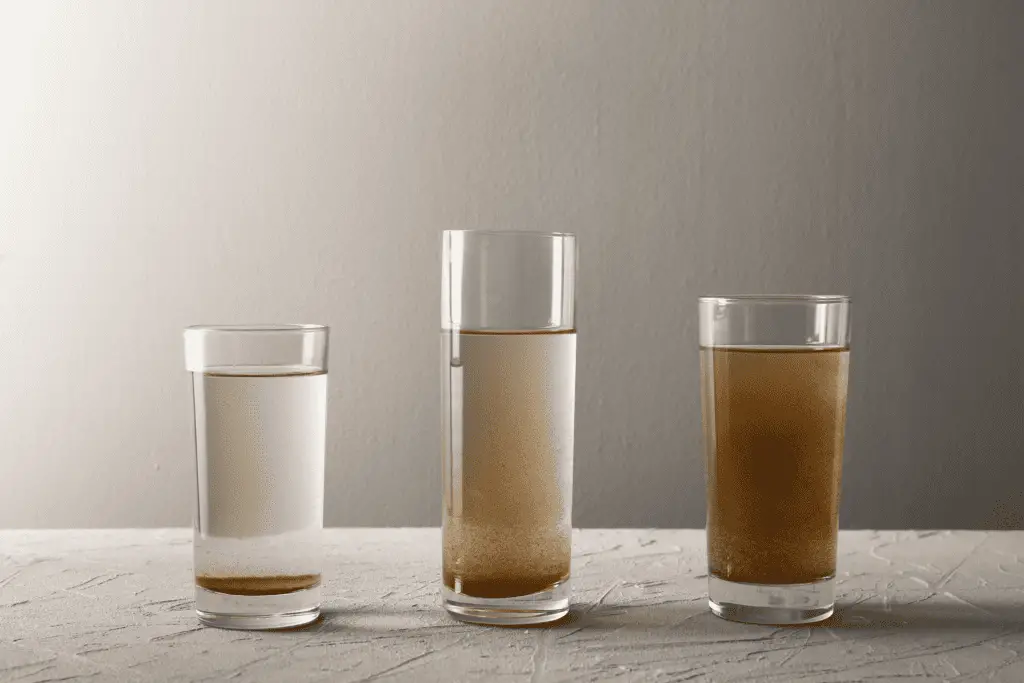Black sediment in well water is a common issue faced by homeowners relying on groundwater as their primary source of drinking water. Understanding the causes of this problem is crucial in order to maintain the water supply’s cleanliness and safety. In this article, we will provide insights into the reasons behind the presence of black sediment in well water and discuss potential solutions for addressing the issue.
One of the main causes of black sediment in well water is the presence of mineral deposits, particularly iron, and manganese. These minerals are known to cause dark staining on plumbing fixtures and appliances, giving the water a brown or black tinge that appears as sediment. Another cause of black sediment is particles from mud, sand, and silt in the well, which could indicate groundwater depletion or a crack in the well casing.
In order to effectively address the issue of black sediment in well water, it’s essential to identify the exact cause and implement appropriate solutions. This can include installing sediment filters, maintaining septic tanks and pipes, and obtaining water test results to ensure a safe and clean water supply for homeowners.
Causes of Black Sediment in Well Water
Minerals and Soil
One of the main causes of black sediment in well water is the presence of minerals and soil particles. These can include sand, silt, and mud that accumulate over time in the well. When they reach the water column, they settle at the bottom of the well, creating the appearance of black sediment. Clay particles from the soil are another common source of sediment in well water. The presence of sediment in well water can also indicate groundwater depletion or a crack in the well casing, allowing these particles to enter the water supply.
Iron and Manganese
Iron and manganese are two minerals known for causing black sediment in well water. These elements can cause dark staining on plumbing, fixtures, and appliances, as well as give water a brown or black tinge. Mineral deposits, specifically iron oxide and manganese, are often the culprits behind well water problems. Elevated levels of these minerals can be a result of natural conditions, such as the composition of rocks and soil, or human activities that affect water quality.
Corrosion and Plumbing Issues
Corrosion of pipes and plumbing is another potential cause of black sediment in well water. Steel pipes can rust over time, and the oxidized iron particles will turn the water black or brown. In addition, water heater and water pipe issues can also lead to sediment accumulation, especially if the pipes are old or made of materials prone to corrosion. As a result, it is essential to check the condition of plumbing systems regularly and make necessary replacements or repairs to prevent sediment issues.
Organic Matter and Debris
The presence of organic matter, such as plant roots or animal hair, can introduce black sediment in well water. Decaying organic materials can gradually sink to the bottom of the well, contributing to the sediment layer. In some cases, heavy rain or flooding can introduce debris, such as leaves and gravel, into the well, which can then mix with the water and create black sediment.
Other Possible Causes of Black Sediment in Well Water
Other factors can lead to black sediment in well water, such as a collapsed well, broken casing, or even a small earthquake in tectonically active areas. Groundwater intrusion into the well can also introduce sediment if the casing is damaged or compromised. It is crucial to investigate and address any peculiar well conditions to ensure the water quality remains safe and free of black sediment.

Detecting Black Sediment in Well Water
Visual Signs and Symptoms
One of the first indicators of black sediment in well water is the appearance of dark particles or staining on plumbing fixtures, such as faucets and appliances. Additionally, the water itself may have a brown or black tinge, which could be a result of mineral deposits like iron and manganese or other particles such as sand or silt.
Furthermore, inspecting the well water for any visible sediment is relatively straightforward. Pour a water sample from the well into a clean container, and visually inspect the water for sediment. If present, using a sieve can help filter the water and collect the sediment for further analysis.
Another visual sign of black sediment in well water could be the presence of mud or sand, which might indicate a temporary issue, groundwater depletion, or a crack in the good casing.
Taste and Smell
Detecting black sediment in well water goes beyond just the visual aspects. The taste and smell of the water can also provide valuable insights. Typically, the presence of minerals such as iron and manganese can alter the taste of water, making it more metallic or bitter. The smell of the water might be described as earthy, musty, or similar to rotten eggs when sulfates are present.
It is essential to pay attention to any unusual changes in the taste and smell of well water. Routine water testing can help identify the presence of black sediment or other contaminants, ensuring safe and clean water for household use.
Well Water System Components Contributing to Sediment
Well Pump and Casing
The well pump and casing play a crucial role in extracting water from the ground, and over time, these components can contribute to the presence of black sediment in well water. Failures or cracks within the well casing can allow sand, silt, or mud to enter the water supply, leading to sediment buildup. Additionally, the degradation of the well pump can introduce iron and other minerals into the water, resulting in the appearance of black sediment, especially on fixtures and appliances.
Water Softener and Heater
Water softeners and heaters are essential components of a well water system, working to remove minerals and heat water for various uses. However, they can also be sources of sediment buildup. Over time, water softeners can accumulate minerals like iron and manganese, which can then be released back into the water, causing black sediment. Similarly, water heaters can develop scale buildup or even corrode, causing metallic particles to enter the water. Regular maintenance and inspection of these components, along with the installation of a water sediment filter or an iron filter, are essential to minimize sediment problems.
Plumbing System and Pipes
The plumbing system and pipes within a home or building can be significant contributors to black sediment in well water. Older metal pipes, valves, and rubber pipes are prone to corroding, releasing rust and other particles into the water. PVC pipes can also degrade over time, introducing plastic particles into the water supply. Furthermore, pressure tanks and plumbing fixtures may develop scale buildup, releasing minerals and sediment back into the water.
To address these issues, consider the following actions:
- Inspect and replace old or corroded pipes and fixtures
- Install a sediment filter or sand separator as a pre-filter for your well water system
- Regularly check and maintain pressure tanks and valves to prevent scale accumulation.
By taking these preventive measures and maintaining the various components of a well water system, it is possible to minimize the occurrence of black sediment in well water and ensure a safe and reliable water supply.

Health Risks and Implications
Nervous System and Essential Nutrients
Black sediment in well water can pose several health risks due to its potential to contain harmful contaminants. One major concern is the presence of heavy metals such as arsenic, which can contaminate private wells through groundwater movement and surface water seepage 1. Prolonged exposure to heavy metals can result in acute and chronic toxicity, leading to liver, kidney, and intestinal damage, anemia, and even cancer 2.
The presence of these contaminants, especially arsenic, can also affect the nervous system, posing long-term health risks. Additionally, heavy metals can disrupt the body’s absorption of essential nutrients, leading to further health complications 3.
Contaminants and Bacteria
Well water with black sediment may also contain other contaminants such as hydrogen sulfide, which can pose risks to human health. While low concentrations of hydrogen sulfide are typically not harmful, higher concentrations can affect taste and odor, leading to gastrointestinal problems.
Moreover, black sediment in well water can indicate the presence of pathogens and harmful bacteria, such as Total Coliforms—the EPA’s indicator of potential water contamination by harmful bacteria originating from human and animal fecal waste. This may also signal the presence of parasitic pathogens like Cryptosporidium and Giardia, which can cause gastrointestinal symptoms.
To minimize the potential health risks posed by black sediment and contaminants in well water, it is essential to employ effective filtration media and regular testing to ensure the water’s safety.
Treating and Preventing Black Sediment in Well Water
Filters and Filtration Systems
The presence of black sediment in well water can be effectively treated using appropriate filtration systems. One common cause of this issue is iron oxide in the water column, which can be addressed by installing an iron filtration system, such as an air injection oxidation system. These units inject air into well water, oxidizing iron, manganese, and hydrogen sulfide to remove them from the water.
For more comprehensive treatment, a water treatment system that includes a sediment filter, sand separator as a pre-filter, manganese or iron filter, and a water softener may be required. A water softener is specifically designed to treat hard water, which contains a high amount of minerals like calcium and magnesium. This not only affects the properties of water but also leaves deposits in plumbing, pressure tanks, and water heaters.
Regular Maintenance and Inspection
To prevent black sediment and other well water problems in the first place, regular maintenance and inspection are crucial. Private well owners should start by doing the following:
- Conduct a water test to identify any issues with water quality and identify harmful bacteria.
- Check the well screen and pump placement to ensure their proper functioning and avoid dirt getting into the well water.
- Inspect the septic system, as leaks or a tank placed too close to the groundwater supply can result in sewage contamination.
In addition to these measures, private well owners should seek the assistance of a well contractor for proper installation and maintenance of the well. This can help avoid issues like poor drilling processes that contribute to sediment formation in well water. A well contractor can also guide owners on the best water filtration system suited for their specific needs and location.
Overall, addressing and preventing the occurrence of black sediment in well water can be achieved by using the right filtration systems and conducting regular maintenance and inspection. With these proactive steps, well owners can ensure the safety and quality of their water source.
Water Quality Testing and Monitoring
Maintaining the quality of well water is essential for the health and safety of those who rely on it. One of the issues encountered with well water is the presence of black sediment, which could be caused by particles from mud, sand, silt, or mineral deposits such as iron and manganese. To address this issue, it is crucial to monitor and test the water quality regularly. This can be done through DIY water test kits or by hiring professional water testing services.
DIY Water Test Kits
Do-it-yourself (DIY) water test kits are an affordable and convenient option for checking the quality of well water. These kits often include tests for various contaminants, such as iron, manganese, water hardness, and other factors that may contribute to black sediment. Make sure to follow the instructions provided by the manufacturer to ensure accurate results.
Key advantages of using DIY water test kits are:
- Cost-effective
- Easy to use
- Available at local hardware stores or online
However, it’s important to note that the accuracy of these kits can vary, and they might not cover all possible contaminants.

Professional Water Testing Services
For a more comprehensive and accurate analysis, consider hiring professional water testing services. These experts use advanced equipment and techniques to evaluate the water quality and identify the underlying causes of issues such as black sediment. They can also provide recommendations on how to address these problems, such as fixing a failing septic tank, replacing old pipes and hoses, installing sediment filters, or implementing water softeners for hard water.
Some benefits of using professional water testing services are:
- High level of accuracy and reliability
- Comprehensive analysis of various contaminants and factors
- Expert guidance on treatment and prevention strategies
Regardless of the testing method used, regular monitoring of well water quality is essential for ensuring optimal water conditions and preventing issues such as black sediment. By addressing the root causes and implementing appropriate treatments, it is possible to safeguard the wellbeing of those who rely on the well water supply.









